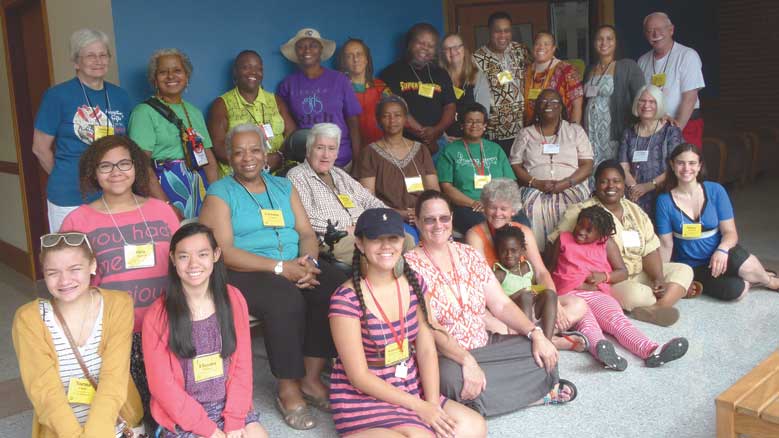
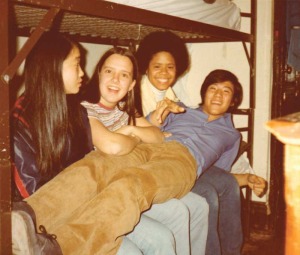
As a child, I was surrounded by Quakers. Members of the Religious Society of Friends were in my schools (the Philadelphia Child Guidance Clinic, the School in Rose Valley, and Westtown School), in my neighborhood (Mantua, and West Philadelphia, Pennsylvania), and connected to my ancestors’ church (the Church of Christ in Ercildoun, Pennsylvania). My first exposure to meeting for worship was when my Quaker friend and classmate invited me to attend her summer camp, Camp Dark Waters in Medford, New Jersey. However, despite being surrounded by Friends, it wasn’t until I was in my 30s that I joined the Religious Society of Friends. Although my father encouraged me many times to become a member, I just did not want to be in a religious community with people who didn’t look like me. All of the Quakers I knew and met were of European descent. I attended predominantly white schools and colleges; the last thing I wanted was to continue that isolation in my religious community. However, I finally joined Friends because it was obvious to me that the values I was raised with and believed in were embedded in Quakerism. So after visiting other churches, I observed that Friends did the best job of incorporating their religious values into their daily lives. Friends definitely did their best to follow their testimonies.
After having my first letter requesting membership lost, six months later I met with a clearness committee and was accepted into membership at Central Philadelphia Meeting in 1993. As a member, I was surprised to experience racism within the Religious Society of Friends. I had been taught that Friends had a special relationship with African Americans. They were abolitionists, established the Underground Railroad, ran schools for African Americans especially in the South, and participated in the Civil Rights Movement—all of which of course meant they were enlightened and above such behavior. Needless to say, I was shocked and couldn’t believe it was happening. I made excuses for their behaviors, told myself I was being too sensitive, and of course thought, “They didn’t mean to hurt me. These Friends are just trying to connect with me and don’t know what to say.”
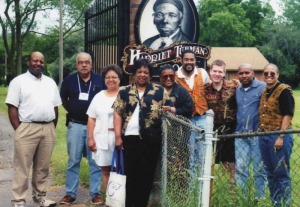
I doubted my experiences until I attended my first Friends General Conference (FGC) Gathering in 1994. There I met other Friends of color and participated in a workshop for people of color only: it was called Internalized Oppression and was facilitated by Anita Mendes. Being a member of that workshop was a transformative experience for me. I was able to hear the experiences of other Friends in their meetings and acknowledge that they were having similar encounters with European American Friends. It was wonderful to learn that I wasn’t imagining these experiences—other Friends of color were having them too. Participating in that workshop planted a seed in me which has grown over the past 20 years: the seed of a ministry working for the abolishment of racism within Quakerism which has grown under the guidance of Central Philadelphia Meeting and other Friends. It began with Paul Ricketts, Anita Mendes, and me spending time the final day of the Gathering writing a letter to FGC asking the organization to support a second year of a people of color only workshop and the establishment of a Center for People of Color.
The following year, 1995, FGC supported the workshop and the Center for People of Color (see my article “Sharing My Light with Other People of Color,” FJ Oct. 1995). The center created programs for all Friends, both European Americans and people of color. We provided opportunities for Friends of color to share their experiences, concerns, and ministries with the Gathering community. We also provided one or two programs for Friends of color to come together in a closed community to get to know each other and try to heal some of the hurts we had acquired either at the Gathering or our local monthly and/or yearly meetings. Eventually I began to perceive a call to respond to requests I was receiving from meetings to facilitate workshops and give presentations on how to make our meetings more welcoming to people of color. In 2000 my meeting gave me a travel minute for this ministry.
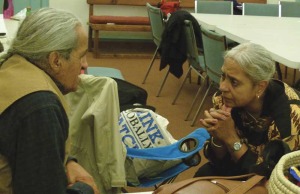
While I was at the FGC Gathering in 1994, I was asked if I would serve on FGC’s Central Committee, the governing body of the organization. I agreed to do so and attended my first meeting that October. I was anxious as I drove to Warwick, New York, and surprised to see only one other person of color there, Japanese American Gordon Hirabayashi, in a room filled with over 100 European Americans. He welcomed me and expressed his pleasure at my presence. Originally my concerns were to increase the enrollment of Friends of color at the Gathering and to improve our experiences there. Several Friends of African descent—Ernie Buscemi, Helen Garay Toppins, Anita Mendes, and Paul Ricketts—joined me in this work. Gradually more Friends of color were appointed to Central Committee. Then in 1997, after the traumatic and painful experience of the Underground Railroad game at the 1996 Gathering in Hamilton, Ontario (see my article “The Underground Railroad Game,” FJ Oct. 1996), members of Central Committee agreed to establish an ad hoc Committee on Racism which originally presented a series of programs for Central Committee to help Friends understand that racism exists within the Religious Society of Friends. These programs were so successful that in 2000 FGC established a permanent committee, the Committee for Ministry on Racism, which expanded the concern for addressing racism to assisting its constituent monthly and yearly meetings. The Ministry on Racism Program also began sending visitors to monthly and yearly meetings.
In 2000 FGC invited me to join Donna McDaniel in co-authoring our book, Fit for Freedom, Not for Friendship: Quakers, African Americans, and the Myth of Racial Justice, which the organization also published. Originally I declined the offer, but God made sure a way opened for me to change my mind and to join Donna in this venture. As we worked on the book and after it was published, FGC supported Donna and me in presenting our work to monthly and yearly meetings. The Ministry on Racism Program also began supporting events at the Center for People of Color during the Gathering. Eventually my term on Central Committee ended, and I stepped away from working with the Ministry on Racism Program. I returned the focus of my volunteer work with FGC to the Gathering until 2005 when FGC raised money to support hiring a part-time staff member. I was invited to apply for the job and was hired.
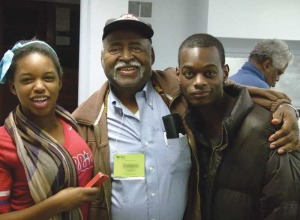
Over the past 20 years I have watched the number of Friends of color involved with FGC increase, and have also seen the work of the Ministry on Racism Program expand. FGC continues to support the Center for People of Color at the Gathering, and provide workshops and visitors for monthly and yearly meetings; we also support Friends who want to attend the White Privilege Conference and offer two annual regional retreats for Friends of color and their families (one prior to the Gathering and the second in the fall).
The retreats for Friends of color have been a very important program. These events are a special and extremely valuable experience for us. I have seen the faces of Friends of color light up when given an opportunity to be in a space with more than one other Friend of color. I have also found relief from my own isolation in facilitating these groups. It is important for us during our time together to share our stories of how we came to Quakerism and what keeps us here. I am fortunate that my meeting, Central Philadelphia, has several Friends of color. We have members of African, Chinese, Japanese, and Latino heritage. Sadly, there are many Friends of color in other meetings who endure their isolation weekly. These retreats provide an opportunity for us to create communities in which we can begin healing some of the wounds that occur and are inflamed week after week as we sit in our meetings feeling that we have had to once again hide parts of ourselves, and assimilate to be accepted.
I know there is a concern about us segregating ourselves. Friends of color crave and need time to be together in community in the same way Friends enjoy coming together for yearly meeting sessions and other Quaker gatherings. Think of the isolation many Friends experience across the country in their home communities, schools, and work environments; well, Friends of color experience that isolation even more strongly. While I was at FGC’s Gathering this summer, I heard repeatedly from Friends of color the challenge they experienced of “entering the sea of whiteness” at registration, in the cafeteria, and for the evening plenaries. I have learned to notice the racial and ethnic makeup of my environment and use that information to assess how I respond. I am used to negotiating in these predominantly white environments, but it is exhausting. Why is it so tiring?
I live in a world where I am constantly reminded that I am African American and that my race and culture are seen as second class. How can I say this? Through my attendance of the 2001 World Conference against Racism (sponsored by the United Nations), work with Niyonu Spann in her Beyond Diversity 101 workshops, and more recently attendance at the White Privilege Conference, I have learned to understand that white supremacy surrounds me every moment of my life. What do I mean by white supremacy? When I turn on the television or the radio, or go to the movies or theater, the main characters are all European American. If there is a person of color, he or she is most likely to be of African descent and play the role of the loyal companion, the traitor, or the sacrifice by being the first character killed. When I was in school, the majority of the books I read in elementary and high school focused on European Americans. The art and music deemed worth exhibiting and performing on a permanent basis in museums and art centers were European, and the history courses available to me focused on Europe or North America. The North American history I was taught was presented from a European American perspective. I was taught that Christopher Columbus discovered America; that the Wild West was civilized by Europeans; and that this country was built by industrious white males. In this history African Americans and indigenous peoples were objects to be managed for this country to progress. I felt shamed, and I hated history. It was not until I was in college that I learned to see history through a different lens, one that showed me that people of color were survivors, who despite the abuse they experienced made tremendous contributions to the establishment of this country. In fact the Americas were inhabited by many different indigenous nations that maintained the land and governed themselves effectively; the West was won by practicing genocide and on confining those remaining native inhabitants in reservations then stealing their land. I also learned that the American empire was built mostly upon the labor of enslaved Africans.
These lessons are put into perspective by a 2004 report called “Structural Racism and Community Building,” published by the Aspen Institute Roundtable on Community Change:
As a society, we more or less take for granted a context of white leadership, dominance, and privilege. This dominant consensus on race is the frame that shapes our attitudes and judgments about social issues. It has come about as a result of the way that historically accumulated white privilege, national values, and contemporary culture have interacted so as to preserve the gaps between white Americans and Americans of color.
The report defines “structural racism” as a term “used to describe the ways in which history, ideology, public policies, institutional practices, and culture interact to maintain a racial hierarchy that allows the privileges associated with whiteness and the disadvantages associated with color to endure and adapt over time.” It goes on to further say, “Because it is a system for allocating social privilege, structural racism affects everyone in our society.”
In her 1993 book, White Women, Race Matters, the late British sociologist Ruth Frankenberg comments on the pervasiveness of racism in our lives: “Whiteness, as an essential normative cultural structure, impacts all aspects of social relations, including understandings of gender and sexual binaries. Modern racism is embedded in the normal routines of our private lives and our public institutions through structural racism.”
Phil Smith, the executive director of the Vermont Developmental Disabilities Council, cites evidence of “whiteness as a function of capitalism” in his 2004 article for Disability Studies Quarterly (“Whiteness, Normal Theory, and Disabilities Studies”):
Whiteness . . . maintains a status quo of social hierarchies ensuring Whites continue to accumulate wealth quite literally on the backs of people of color (Newitz and Wray 1997). It ensures that a set of unearned but real financial and social privileges are maintained for Whites at the expense of others, through spheres that include housing, banking, property ownership, access to capital, and employment (Kincheloe 1999; Stephenson 1997).
Over the past four years FGC has supported more than 160 Friends from 16 yearly meetings to attend the White Privilege Conference by offering a group discount on registration. Many of these Friends are using the awareness and skills that they learned there to identify and address racism in their meetings and even in FGC. For example, this year several Friends reached out to FGC’s administration with a shared concern after the organization held a special invitational consultation that was supposed to be representative of primarily unprogrammed Friends in North America—only two of the sixty Friends present were Friends of color. One of the results of supporting this work is that our constituency’s awareness of errors has increased, so when FGC makes mistakes, Friends hold the organization accountable, thus assisting in making the change that we want to see within the Religious Society of Friends.
However, even with providing all of these services so much more needs to be done. The number of people of color on Central Committee has increased (from two in 1994 to ten in 2014), but we are always looking for more Friends of color to participate. It would be wonderful if FGC’s staff, committees, and working groups each contained several Friends of color. FGC has progressed in their efforts in raising awareness of racism within the Religious Society of Friends. We do have much more work to do. I am excited that the organization has agreed to assist with hosting the White Privilege Conference in the Philadelphia area in 2016. Over the past year we have been reaching out to both Quaker and non-Quaker organizations to help us form the host team which the conference’s guidelines require.
As Friends, we want to believe that we are separate from the American culture we are immersed in daily. Researching and writing Fit for Freedom, Not for Friendship helped me understand that white privilege is very much a part of who we are. White supremacy is a part of our meetings because it is the foundation upon which the Religious Society of Friends has been established in this country. Enslavement, segregation, and assimilation are a part of Friends history. My rationale for this statement is fully explained and supported in our book which I highly recommend. If we want our meetings to have more members of color, we need to understand the role that white supremacy plays in our community. I want to invite Friends to take off their blinders and begin to see and examine the norms that our white supremacist culture surrounds us in every day: learn about the structural racism framework, how individuals benefit from it, and how it prevents us from creating the Blessed Community we seek.
Join FGC at the 2015 White Privilege Conference (WPC16 for sixteenth annual) on March 11–14, 2015, in Louisville, Kentucky. Registration opens on January 19, 2015 (Martin Luther King Jr. Day). FGC will be sponsoring a group discount for a fifth year (go to fdsj.nl/FGC-WPC16 to sign up). WPC17 will be held in the Philadelphia area in 2016. Visit the conference website (whiteprivilegeconference.com) for updates.
Help your meeting challenge racism by requesting a workshop by FGC’s Ministry on Racism Program. Go to fdsj.nl/FGC-MRP for more resources and details.
Related:
Our Quakerspeak project recently interviewed Vanessa Julye


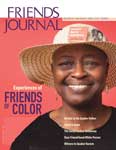
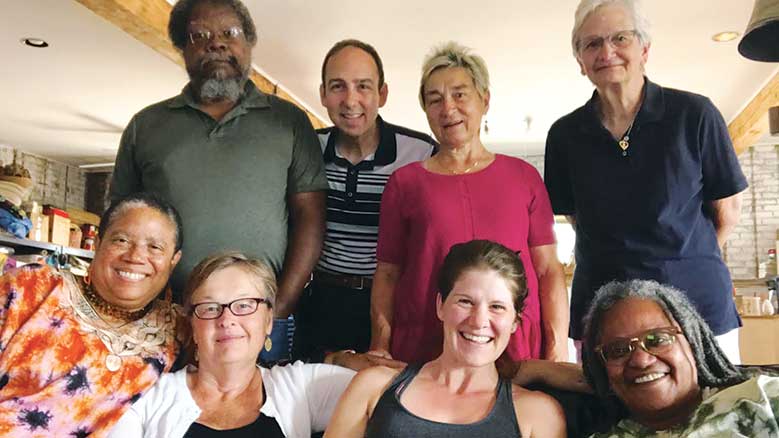
This one paragraph speaks for me, Friend Vanessa. Thank you so much for it.
“If we want our meetings to have more members of color, we need to understand the role that white supremacy plays in our community. I want to invite Friends to take off their blinders and begin to see and examine the norms that our white supremacist culture surrounds us in every day: learn about the structural racism framework, how individuals benefit from it, and how it prevents us from creating the Blessed Community we seek.”
As usual, Vanessa, you hit it out of the ball park with this article. As painful as everyday racism is for people of color and as confused and ignorant as it keeps us whites if we don’t make an extra effort, structural racism operates to hide the real dynamics of capitalism that keep almost everybody — including many Quakers — in a pattern of automatic deference to the (white) Masters of the Universe, the 1 percent. You also offer a ray of hope when you imply that it was mostly whites who stood up to correct FGC’s choice of delegates. By standing up in our own institutional settings we whites practice the assertiveness that we’ll need, redoubled, when standing up to the 1 percent’s decision to, among other things, trash public education in this country and refuse to address a climate crisis that, as the folks in New Orleans can tell us, disproportionately hurts the poor and people of color.
But most of all I want to salute your resilience and pluck in pursuing your ministry despite the challenges you encounter. The spirit of Fox’s Valiant Sixty lives on! Thank you for your embodiment of the old Quaker characteristic of plain and direct speaking.
George Lakey
The sad thing is a certain Quaker well-intentioned blindness. It is one thing to want to bring heaven to earth at the present moment (‘the Second Coming is now’ of early Friends); it is another to think we have got there. We constantly assume that we have a gift for the world – ‘the world needs us’ – without realising that we are part of that world. We also share its prejudices, inconsistencies, and self-righteousness. We try to be nice to each other without recognising the hurts we cause each other. Perhaps we need more modesty? And, dare I say, repentance?
Although som people are still used to the terminology of “people of color”, as shown in your last topic, this word has been erased for a long time from the academic circles such as in Columbia NY, Harvard, Princeton etc. Some people, especially those from Asian backgrounds do feel this word stink. “White” is a color and is not a “non-color”. Why don’t you change the word to “non-white” to denote a people that you are talking about – just as the Asians would describe the others as “non-Asian”. Or otherwise people can suitably say the other people as a “non-black”, “non-South-Americans” and so on. That way makes your rhetoric more logical and acceptable, and makes Quakerism more universal. Please take my suggestion into your consideration and comment.
The Rev Dr Naoshi Hinami, an attendant of North Seattle Friends
It is hard to speak of White Supremacy with White People. The white people we meet in our generation are as defensive as we the people of color are. The reason why is, they are being forced to swallow the “White Supremacy” label, while we all know that they are not guilty of the atrocities of their ancestors. Another problem I see going on is, that there is ostracism by African Americans against blacks who were not born or raised in the United States. Segregation is happening at all levels, from all possible organized groups. Perhaps it would help to lower the tone and do not accuse White Quakers of being racist. I wish that people in the same religious community would not use the “White Supremacy” label on their own peers. Love One Another still works sometimes. I am aware that the Quakers have had a history in the KKK already. So, please forgive my candor. I may be just using my right to be mistaken.